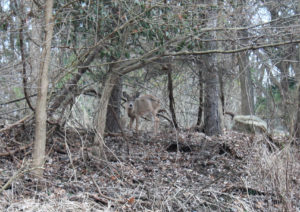Gardening’s Worst Threat?
February 19th, 2019
One gardening challenge I’ve never had to deal with is arguably the worst one: deer.
These four-legged eating machines can take out half of a yard’s landscaping in a single night. And they’ve learned that people aren’t a threat but rather a sign that tasty vegetation is nearby.
Groundhogs, voles, chipmunks, and rabbits gave me a lot of trouble in 30 years of gardening in Hampden Twp., but at least I never had to worry about deer.
Now that my wife and I have moved to a quiet, wooded neighborhood in suburban Pittsburgh, deer are on the front burner.
I saw chomped hosta and piles of brown “deer pellets” in the lawn while house-hunting. Then I saw a pair of does munching nonchalantly in a neighbor’s back yard while the neighbor was out mowing with a rather loud gas-powered riding mower.
No fear at all there.
Since moving, I’ve seen at least three deer browsing the vegetation of my new back bank.
This is very bad news for a gardening nut who dug up, potted, and took some 200 fine plants halfway across the state.
Before I plant any of it, I’m activating my defenses.
That’s right… a border wall.
My borough allows 6-foot-tall solid fences right up to the property line out back, so that’s what I’m going to do.
Deer can jump that high, but I’ve heard they’re reluctant to jump into what they can’t see.
I’ll find out.
The front yard is a different story. I’d like to bring a fence out from the far house corner to extend the side yard about 20 feet into the big, wasted-grass front yard. That would be a perfect, sunny place to grow vegetables and herbs.
However, borough rules say no out-front fence can be higher than three feet – and it has to be 50 percent open, too. In other words, a picket fence.
The former owners told me the deer tend to stick to the back yard, but I have no doubt their interest in the front yard would go up (the deer, not the former owners) if tomatoes and blueberries were growing there.
So I’ll probably drop the fence idea and rely on repellents to protect anything I try out front.
Repellents can work if you keep the scent on regularly, and if necessary, rotate different ones.
I’m going to start with one called Bobbex that rated No. 1 out of 10 repellents tested at the Connecticut Agricultural Experiment Station.
This one uses a blend of scent and taste ickies… ingredients including “putrescent” eggs, fishmeal, fish oil, garlic, urea, and Epsom salts.
The idea is that if the yucky scent doesn’t shush them away, they won’t like the taste sample. Supposedly, the scent isn’t noticeable to people after 24 hours.
“Hunting has reduced deer densities in large, wooded open spaces across the country over the past decade,” says Dr. Scott Williams of the Connecticut Agricultural Experiment Station. “Many deer remain, however, and are now largely concentrated in residential areas where they have abundant ornamental plants to browse and where little or no hunting occurs.”
With lots of lush, well watered plants and no natural predators, gardeners’ yards look pretty enticing.
Like my new yard.
I’m hoping that between a fortress in the backyard and some nasty scents in the front, I’ll quickly train my Pittsburgh deer to go somewhere else.









